Статьи журнала - Saratov Medical Journal
Все статьи: 92
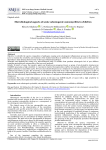
Microbiological aspects of acute odontogenic osteomyelitis in children
Статья научная
Objective: to identify the species composition of pathogens causing acute odontogenic inflammatory process in the children’s jaws; to examine the sensitivity and resistance of the isolated microflora to antibiotics of various groups; and to determine the dependence of the disease clinical course on the type of dominant pathogen. Materials and Methods.The results of a microbiological study of exudate from purulent odontogenic foci of 900 children regarding periostitis and osteomyelitis of the jaws were analyzed. Results. In 65.6% of cases, the causative agent was Streptococcus pyogenes known as group A beta-hemolytic streptococcus (GABHS) possessing a high sensitivity to vancomycin (99%), fluoroquinolones (98%), beta-lactam antibiotics (91%), and the highest resistance to macrolides (41%). We have also isolated Streptococcus viridans (6.1%), Streptococcus pneumoniae (4.3%) andmixed microflora (14.3%). The syndrome of endogenous intoxication of the body was manifested by high fever in 56% of cases, by leukocytosis in 38% of patents, and by acceleration of the erythrocyte sedimentation rate in 57.4% of study subjects. There was no statistically significant difference in the degree of endogenous intoxication between groups with different types of streptococci. Conclusion. The cause of the inflammatory process in the jaws was GABHS (65.6% of cases) with a high sensitivity to vancomycin (99%), fluoroquinolones (98%), and beta-lactam antibiotics (91%).
Бесплатно
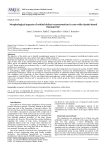
Morphological aspects of orbital defect reconstruction in rats with elastin-based biomaterial
Статья научная
The objective of the study was to identify morphological aspects of replacement of xenogeneic decellularized elastin matrix (ХDEM) transplanted into a bone defect of the upper orbital wall in rats. Materials and methods. The experiment was performed on 60 Wistar rats with artificially created 7×4 mm defect in the upper edge of their orbit. In the experimental group (n=30), DХEM was placed in the defect area. Its size matched the size of the defect, and it was attached with a suture material (50 μm silk). Soft tissues were sutured layer by layer in the control group (n=30). Tissue excision was performed after 1, 3 and 12 months. Histological, immunohistochemical and electron microscopic methods were employed. Results. We were gradually replacing DХEM with bone tissue against the background of a pronounced reaction of CD68+/MMP-9+ macrophages, which implied its resorption and lysis. Osteogenesis occurred via intramembranous ossification and endochondral ossification, which was preceded by centripetal migration of endothelial kidneys with subsequent differentiation into capillaries and overgrowth of loose fibrous connective tissue containing progenitor cells. The microenvironment, represented by reticulin fibers, TGF-β1, and sulfated glycosaminoglycans, could contribute to the differentiation of progenitor cells in the osteogenic direction and to osteogenesis per se. In the control group, the defect remained open throughout the experiment. Conclusion. Decellularized biomaterial, based on elastin matrix, has osteoconductive and osteoinductive properties and can serve an adequate biomimetic for reconstruction of the bone defects.
Бесплатно
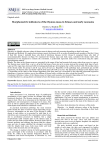
Morphometric indicators of the thymus mass in fetuses and early neonates
Статья научная
Objective: to identify reference values of thymus mass in fetuses and early neonates depending on their body mass. Materials and Methods. We analyzed 922 autopsy reports for fetuses of 18-42 weeks of gestation and neonates of the first 7 days of their life: Group I included those who died of infectious diseases (n=67); Group II comprised those who died of noncommunicable diseases (n=855). We examined the thymus mass and body mass, calculated the thymic index (TI). Spearman’s R was employed to evaluate the correlation. A polynomial regression model was constructed using the spline approximation method. Results. The data on the thymus mass are presented in the range of fetal and neonate body mass values from 300 g to 5,500 g. The thymus mass varied from 1.1 g to 1.48 g (for fetal mass of 300-500 g) to 12.36 g-15.09 g (for neonate body mass of 400-5,500 g). The organ mass increased with increasing gestational age, decreasing by day 3 of the newborn’s life. The median values of the thymic index for groups I and II 0.32 and 0.28 (p=0.2). Regardless of the pathology type, gestational age and life expectancy, the thymus mass correlated with the body mass (R=0.88; p<0.001). The dynamics of changes in the thymus mass (y) depending on the values of the decimal logarithm of the body mass (x) is described by the following polynomial regression equations: y=13.937x2-75.662x+104.47 for children of Group I and y=16.65x2-93.487x+133.56 for Group II. Conclusion. Reference values of the thymus mass in fetuses and neonates are presented depending on their body mass: we revealed that there is a strong direct correlation between the thymus mass and the body mass.
Бесплатно
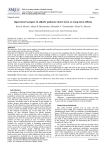
Open-heart surgery in elderly patients: short-term vs. long-term effects
Статья научная
The objective of the study was to analyze in-hospital mortality and long-term survival of elderly patients who underwent open-heart surgery and met the criterion of frailty. Materials and Methods. The study involved 266 patients over 75 years old complying with the frailty criterion (F-index ≤5). A total of 155 operations of coronary artery bypass grafting (CABG), 47 surgeries of aortic valve replacement (AVR), and 64 procedures of CABG in combination with AVR were performed. Study subjects were distributed among the groups depending on the surgery type. Postoperative complications were evaluated, and short-term and long-term outcomes were compared. Results. In-hospital mortality was 5.3% in general group, 9.4% in CABG+AVR group, 3.9% in CABG group, and 4.2% in AVR group. There was no significant difference among the rates of in-hospital mortality between the groups (р>0.05). Long-term survival rates in general group were as follows: 98.3% for 1-year survival, 94.6% for 3-year survival, and 82.1% for 5-year survival. Type of surgery had no significant impact on the outcome (р>0.05). Conclusion. Short- and long-term effects of CABG, AVR, and combination of CABG with AVR in the group of elderly patients who meet the criterion of frailty were characterized by low mortality and low incidence of non-fatal complications. The type of cardiac surgery and old age did not affect significantly the outcome of a surgical treatment.
Бесплатно
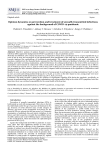
Статья научная
Objective: analysis of opinion dynamics in young people on prevention and treatment of sexually transmitted infections (STIs) against the background of COVID-19 pandemic vs. the pre-pandemic period. Materials and Methods. Our research was based on a comparison of data from a sociological survey of 400 respondents 16-21 years of age in 2021 and an analysis of 838 questionnaires from participants of the same age in a similar study in 2017. The research employed the methodology of sociological questionnaire. The original questionnaire was used, consisting of 46 questions, combined into five thematic blocks: assessment of the STI problem relevance, likelihood of infection risk, readiness to undergo preventive screening examinations, preferred directions for seeking medical help in the event of STI, and consent to examination and treatment in conjunction with a sexual partner. By gender, the distribution of study subjects was as follows: 51% of women (n=427) in 2017 vs. 52% (n=208) in 2021; 49% of men (n=411) in 2017 vs. 48% (n=192) in 2021. In processing and presenting the data, extensive indicators were used, compared with the assessment of the significance of differences sensu Student’s t-test. Results. In 2021, we observed an increase in the interest of young people in undergoing screening examinations (79.5% vs. 63% in 2017, p=0.006) and seeking medical help (93.5% vs. 89.5%, p=0.007); on the other hand, in 2021, young people were more likely to conceal their health status from a partner (32.2% vs. 8.3%, p=0.003). Conclusion. The study revealed a change in the opinions of respondents regarding STIs during the pandemic, specifically, an increase in understanding the need for regular examinations and seeking medical help in the event of STI symptoms, but at the same time, there was a reduced responsibility for the sexual health of their partner.
Бесплатно
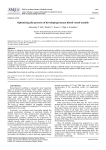
Optimizing the process of developing human blood vessel models
Статья научная
Objective: to optimize the process of blood vessel biomechanical modeling via developing models of cerebral arterial circle. Materials and methods. Biomechanical modeling requires development of a patient-oriented three-dimensional (3D) solid-state geometric model of the object under study. This task can be resolved by computed tomography (CT) or magnetic resonance imaging (MRI). We developed the program that implements the construction of blood vessel contours from separate slices of MRI in a semi-automatic mode. These contours are exported as saved curves in a specific format to SolidWorks, where they are used to create 3D models of blood vessels. The models obtained this way take into account individual characteristics of the vascular system structure of a particular patient, and can be used in the process of biomechanical modeling. Results. The results of the program implementation of the recursive frontal growth method for processing 2D slices of tomograms are presented. Conclusion. The developed software allows semi-automatic loading of DICOM images and obtaining flat cross-sections (MRI slices) of vessels on their basis, as well as transferring them for further processing into computer-aided design systems.
Бесплатно
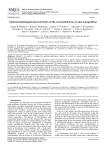
Pathomorphological characteristics of the wound bed prior to skin autografting
Статья научная
Objective: to conduct a comparative pathomorphological analysis of wounds of various origins requiring full-thickness skin autografting. Materials and Methods. Histomorphological comparison of the wound bed prior to plastic surgery with full-thickness skin autografts was performed in three groups of patients: (1) during excision of scar tissue in elective surgery; (2) in case of traumatic skin detachments with autografting sensu Krasovitov; (3) when excising the granulation tissue to the fibrous layer. The object of the study included biopsy specimens from patients of three study groups. Results. The histological picture of wounds after removal of scars was characterized by well-developed dense fibrocellular connective tissue and had signs of chronic inflammation. In contrast to the cicatricial wound, acute lesions were characterized by granulation and mature dense fibrous connective tissues with pronounced inflammatory changes, each of which had its own characteristics. Conclusion. The results of the comparative analysis revealed the features of the morphological picture of wounds depending on the type of damage. In the group of acute injuries, traumatic and burn wounds, the most pronounced tissue damage was revealed. Given the obtained data, it should be assumed that full-thickness skin autografting will yield the best result in the group of patients after the planned excision of scar tissue.
Бесплатно

Pentraxin 3: possibilities and prospects for using a biomarker in patients with COVID-19
Статья научная
Objective: to determine the potential predictive value of serum biomarkers for adverse cardiovascular events in post-COVID-19 patients. Materials and Methods. The prospective study included 114 patients hospitalized with confirmed COVID-19. In addition to standard examinations, blood samples were collected on the day of admission to determine levels of serum cardiovascular biomarkers, including pentraxin 3 (PTX3). Patients were monitored for 366 [365; 380] days after discharge from the COVID-19 hospital with registration of all major adverse cardiovascular events (MACE) that developed. Results. During follow-up, we observed MACE in 19 patients (16.7%), including 2 deaths (1.8%) from cardiovascular causes. The incidence of MACE was higher in patients with higher concentrations of PTX3 (OR 1.28, 95% CI 1.13-1.45; p<0.001), interleukin 6 (OR 1.01, 95 % CI 1.0-1.02; p=0.048), D-dimer (OR 2.05, 95% CI 1.16-3.6; p=0.019), lactate dehydrogenase (OR 1.08, 95% CI 1.03-1.13; p<0.001), and MB fraction of creatine kinase (OR 1.19, 95% CI 1.02-1.39; p=0.001). PTX3˃3.1 ng/mL predicted the development of MACE with a sensitivity of 94.0% and specificity of 82.1% (AUC 0.885; p<0.001). Conclusion. Serum biomarkers, in particular PTX3, can be used to predict the development of MACE in the long-term follow-up of post-COVID-19 patients.
Бесплатно
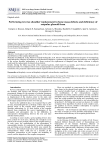
Статья научная
Objective: development and efficacy assessment of the tactic of actions in reverse shoulder arthroplasty in bone mass defects and deficiency of the scapular glenoid fossa. Materials and Methods. At the Division of Adult Orthopedics, N.N. Priorov National Medical Research Center of Traumatology and Orthopedics, Ministry of Healthcare of the Russian Federation, 6 patients with glenoid bone mass deficiency were subjected to the reverse shoulder arthroplasty: 4 of those received the replacement of marginal bone defects, whereas 2 subjects underwent the replacement of extensive bone defects. Results. During the follow-up period of the operated patients, which lasted 6-24 months, good clinical, radiological and functional results were obtained. There were no intraoperative or postoperative complications. Conclusion. The proposed replacement method of glenoid defects in reverse arthroplasty exhibited high efficacy.
Бесплатно
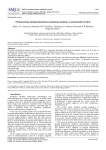
Perimortem and postmortem caesarean section: a systematic review
Статья научная
Rationale: Perimortem caesarean section (PMCS) is an emergency procedure performed in pregnant women over 20 weeks of gestation with cardiac arrest, in order to save the mother and the foetus, or only one of them. The objective of the review was to present clinical traits and evaluate survival of mothers and newborns as well as the complications following PMCS. Materials and methods: A systematic review between March and May 2021 was performed using the PRISMA method with the terms "perimortem caesarean section" "postmortem caesarean section", "maternal cardiac arrest", "perimortem caesarean section "AND "case report" "postmortem caesarean section" AND "case report". Results: 23 papers from 12 countries with 39 cases were counted. Of the total sample, 17.94% of the mothers survived and of these, 42.85% had neurological complications. Of 39 newborns counted, 69.23% survived, 28.20% died and in 2.56% the information was missing. 30.76% of the cases followed the five-minute rule and 56.41% required 6 or more minutes, 12.82% did not specify time. Conclusion: The results of this analysis demonstrated higher mortality in women who had a cardiac arrest during pregnancy related to the neonates who survived. The possibility of performing PMCS should neither be ruled out even if the established five-minute time frame has passed, nor should time be invested in verifying foetal viability.
Бесплатно
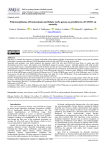
Polymorphisms of hemostasis and folate cycle genes as predictors of COVID-19 severity
Статья научная
Objective: to identify the frequency of single nucleotide polymorphisms (SNPs) of hemostasis and folate cycle genes in patients with stable coronary artery disease (CAD) depending on the severity of COVID-19 in the acute period. Materials and methods. Our study included 416 patients with CAD who had COVID-19 more than 12 weeks ago with documented severity course. All patients were distributed among two groups. Group 1 included patients with mild severity (n=203), while Group 2 comprised patients with moderate severity (n=213) of COVID-19. All study subjects were examined for polymorphisms of hemostasis and folate cycle genes. We performed an assessment of the following genetic variants: 20210 G>A of the F2 gene, 1691 G>A of the F5 gene, 807 C>T of the ITGA2 gene, 10976 G>A of the F7 gene, 1298A>C of the MTHFR gene, 66 A>G of the MTRR gene, 2756 A>G of the MTR gene, 677 C>T of the MTHFR gene, 455 G>A of the FGB gene, 103 G>T of the F13A1 gene, 675 5G>4G of the SERPINE1 (PAI-1) gene, and 1565 T>C of the ITGB3 gene. These polymorphisms are likely to contribute to a more severe course of COVID-19 in patients with CAD. Results. Predisposing factors for the development of a more severe course of COVID-19 among patients with CAD may be the presence of heterozygous polymorphism (455 G>A) of the FGB gene and 1565 T>C polymorphism (CC genotype) of the ITGB3 gene. Contrariwise, the 807 C>T polymorphism (CC genotype) of the ITGA2 gene in the analyzed sample was associated with a mild course of COVID-19. Conclusion. SNPs 455 G>A of the FGB gene and 1565 T>C (rs5918) of the ITGB3 gene are potential markers for identifying and predicting a more severe course of COVID-19 in patients with CAD
Бесплатно
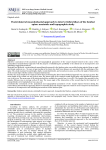
Статья научная
Objective: assessment of the anatomical and topographical parameters of the wound channel formed in the course of the posterolateral musculofascial approach with the purpose of identifying the possibility of its clinical use in decompressive and stabilizing surgical interventions. Materials and Methods: a posterolateral musculofascial approach to the lumbar spine was modeled using material from 20 male and female cadavers 54 – 76 years of age (median 67.5 years) who died from diseases not associated with the pathology of the spine. The study examined wound length, depth, wound depth index, and wound access zone, as well as the angle of intersection of the wound edges with the surface of surgical instruments. Results: the mean length of the surgical wound when performing the lateral musculofascial approach was 149.75±6.35 mm. The mean depth of the wound was 116.75±8.85 mm. The mean value of the surgical wound depth index with interfascial approach was 77.96±5.04. The mean area of the intervertebral disc available for removal was 71.2±2.8%. The length of the aperture in the annulus fibrosus was on average 15.8±0.78 mm. The mean angle of the intersection of the wound edge by the trajectory of transpedicular screw implantation was 3.15±1.25°. Conclusion:the assessment of the anatomical and topographical parameters of the wound channel formed during the posterolateral musculofascial approach allowed concluding that such surgical approach could be used to improve the functional outcomes of decompressive and stabilizing interventions on the lumbar spine.
Бесплатно
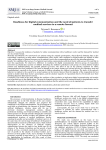
Статья научная
Objective: to assess the readiness of patients for online communication with a healthcare worker and the demand for medical care in a remote format. Materials and Methods. We interviewed 507 patients using the original questionnaire, which allowed obtaining data on the respondents’ experience in using online communication with a doctor, their readiness for digital health care instead of office visits, and the impact of Internet resources on the patient’s trust in the recommendations given by the attending physician. Results. We established that 30.6±2.1% of patients used online communication with their doctor, while 40.5±2.2% would like to have this opportunity. We observed a difference in readiness for digital communication between groups of respondents interested in pediatricians (parents of children attending city children’s polyclinics) and groups of central district hospital patients and multidisciplinary city hospital patients (p<0.001). The effect of age on the patient’s readiness for online communication has been confirmed. The most in demand in the remote format were referral services (for laboratory tests and hospitalization), especially in the group of parents of children attending city children’s polyclinics. The study of the patient’s behavior in relation to the search for a second opinion on the Internet showed that the majority of the respondents did not intend to double-check their doctor’s prescriptions, and the absolute majority of respondents (82.8±1.7%) trusted more their attending physician than Internet sources. Conclusion. The results of the study indicate the readiness of the population to implement digital communication and transfer part of medical care to the digital sphere. The most in-demand services were those for issuing referrals for hospitalization and to specialists, as well as for tests and pharmaceutical prescriptions that the patient receives on an ongoing basis.
Бесплатно

Статья научная
Objective: to identify the relationship between the results of in silico and in vivo studies of hypoglycemic, hypolipidemic, and hepatoprotective properties expressed by a new 1,4-dihydropyridine derivative with the laboratory code AZ-383. Material and Methods. Virtual biological screening of the AZ-383 compound was conducted using SwissTargetPrediction online tool. The identified biotargets were promising for pharmacological correction of multiple metabolic disorders, which was confirmed in an in vivo experiment conducted on male Wistar rats: the levels of glucose, total cholesterol, triglycerides, alanine aminotransferase, aspartate aminotransferase, and total bilirubin in the blood were examined; the microarchitecture of the rat liver was assessed after pharmacological correction (using the AZ-383 compound) of the modeled metabolic disorders. Results. The presence of hypoglycemic, hypolipidemic and hepatoprotective properties in the compound AZ-383, along with its favorable effect on body weight, was revealed. The glucose level reached values of 7.9±0.4 mmol/L. The body weight of rats after the use of AZ-383 was 378±12 g. Under the influence of AZ-383, we observed an increase in the number of hepatocytes by 17.8%, a reduction in the size of hepatocytes by 7%, and a decrease in the area of the cytoplasm and nuclei of hepatocytes by 5.2% and 18.7%, respectively, vs. the control group of animals. Conclusion. Our in vivo experimental study confirmed the presence of hypoglycemic, hypolipidemic and hepatoprotective properties in the AZ-383 compound, which corresponds to the biotargets determined in silico for this 1,4-dihydropyridine derivative.
Бесплатно

Republican Arthrology Center and its contribution to the development of orthopedic rheumatology
Статья научная
The article provides information on the organization and functioning achievements of the Republican Arthrology Center (RAC), which has become the first specialized clinic in the Russian Soviet Federative Socialist Republic (RSFSR) that provided arthrological assistance to the population. The result of the organizational and methodological efforts of the RAC employees was the development of a network of rheumatology rooms in almost all territories of the country, along with the organization of the orthopedic rheumatology service and its separation from the cardiovascular rheumatology service. In the RAC, scientific developments were successfully carried out on the problems of arthroplasty of large joints, surgical and conservative treatment of patients with rheumatoid arthritis, osteoarthritis of large joints, prevention of contractures of the knee joint. Saratov Research Institute of Traumatology and Orthopedics (SRITO) hip joint endoprosthesis, a collapsible endoprosthesis and other constructions that have received wide recognition were created at the RAC. In the absence of international experience in creating an orthopedic rheumatology service network, the RAC was, on one hand, a pioneering phenomenon in world health care, and on the other hand, a natural consequence of the power vertical centralization in the USSR. At the same time, it should be emphasized that the need to create the RAC in the Russian Federation was caused by the growth in morbidity of rheumatic diseases, along with population aging and the prospects of orthopedic rheumatology associated, first of all, with the active introduction of total joint replacement with artificial structures in developed countries of the world. Over three decades of its existence, the RAC has been an organizational, methodological, medical, scientific and consulting center providing an orthopedic care to patients with diseases and injuries of large joints throughout the Russian Federation.
Бесплатно
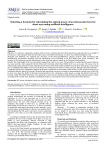
Статья научная
Objective: to conduct a comparative analysis of the accuracy of intraocular lens (IOL) selection in patients with an eye length of less than 22.0 mm using the Barrett Universal II, Kane, and Hoffer Q formulas, as well as via artificial intelligence (AI). Materials and Methods. We analyzed the outcomes of 88 phacoemulsification cataract surgeries with monofocal IOL implantation. Preoperative biometry and IOL calculations were performed on an IOL Master 700 (Zeiss, Germany). The accuracy of IOL selection was also determined via the LensCalc software based on AI (DecisionTreeClassifier). Results. The axial length of the eyes in patients ranged from 19.8 to 22.0 mm. The prediction of achieving the target refraction was most accurate when using the Barrett Universal II formula rather than Hoffer Q (Z=2.12; p=0.034). The mean error in achieving the target refraction when using the Barrett Universal II formula did not differ from the Kane formula (p>0.05). Using AI, we established that higher accuracy in the IOL power calculation was achieved when using the Barrett Universal II formula. Conclusion. Based on a comparative analysis of the study results and an assessment of the accuracy of IOL selection using AI, we established that the Barrett Universal II formula (4th generation) was more accurate in determining the optical power of the IOL in short eyes than the Hoffer Q formula (3rd generation). Our calculation results based on using the Barrett Universal II formula, unlike the Hoffer Q formula, were similar (p>0.05) to those calculated using the Kane formula (5th generation), which, according to the results of the majority of published studies, is currently the most accurate formula for IOL selection.
Бесплатно
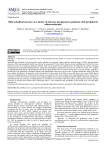
Skin autofluorescence as a factor of adverse prognosis in patients with peripheral atherosclerosis
Статья научная
Objective: to determine the prognostic value of skin autofluorescence (SAF) as a factor of cardiovascular complications and mortality. Materials and Methods. Our prospective study included 122 patients with peripheral arterial disease (PAD): atherosclerotic stenosis of the brachiocephalic trunk was detected in 95 patient (77.9%), while chronic arterial insufficiency (CAI) of the lower limbs was found in 47 study participants (38.5%). SAF was measured by an original device developed by the authors. Clinical, anthropometric and biochemicalparameters, along with instrumental parameters of the heart and blood vessels, were studied via ultrasound examination. The prospective part of the study (follow-up) was carried out for up to 1,043 (on average, 736) days. Results.The SAF parameter correlated directly and significantly with scores on the scale of clinical prognostic signs, CAIof the lower limbs, and history of surgeries on the leg arteries. In the course of the follow-up period, there were seven deaths and at least one hospitalization for cardiovascular reasons in 42 patients. The most common were hospitalizations due to conservative treatment of CAI, the need for coronary artery bypass grafting, and coronary stenting. Using the logistic regression method, we determined that the incidence of hospitalization or mortality was associated with SAF values, plasma glucosecontent, and the presence of chronic heart failure above functional class 1. The sensitivity and specificity of the model were 71% and 68%, respectively. Conclusion.The SAF parameter can be used as an integral independent predictor in patients with multifocal atherosclerosis.
Бесплатно
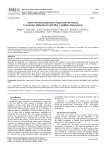
Stress-strain properties of aponeurotic suture in anterior abdominal wall after a midline laparotomy
Статья научная
Objective: method development for preventing postoperative ventral hernias based on experimental assessment of the stress-strain properties of aponeurosis in various types of a midline laparotomy. Materials and methods. We evaluated 42 fascia muscular aponeurotic complexes of the anterior abdominal wall. Based on the technique for dissecting the aponeurosis and its suturing, the complexes were divided into two groups (each containing 21 samples): Group 1 with a bypass of the umbilical ring on the left, and Group 2 with umbilical ring dissection. Results. Fascia aponeurotic complexes dissected and sutured through the umbilical ring (Group 2) had, on the average, higher values of mechanical characteristics. E.g., mean values of tensile stress (S), tensile stress at a maximum load (Smax), Young’s modulus (E), aponeurotic tensile strain (D), aponeurotic tensile strain at a maximum load (Dmax), and maximum load level (Load) were higher in Group 2 by 35.4; 39.8; 14.9; 34.6; 30.2 and 40.2 (%), respectively. Conclusion. We conducted the development, experimental application and evaluation of a novel method for preventing postoperative ventral hernias after a midline laparotomy based on the assessment of the stress-strain properties of aponeurosis.
Бесплатно
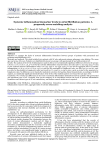
Статья научная
Objective: to compare the levels of systemic inflammation biomarkers between groups of patients with paroxysmal and persistent atrial fibrillation (AF). Materials and methods. The study included 232 patients with AF who underwent primary pulmonary vein ablation. The mean age was 62 (54; 67) years. Patients were distributed between two groups: with paroxysmal AF and with persistent AF. Results. The analysis of the levels of inflammatory markers did not reveal statistically significant differences between the groups: 0.8 (0.6; 1.1) vs. 0.9 (0.7; 1.1), p=0.077 for the systemic inflammation response index; 361 (276; 509) vs. 373 (294; 551), p=0.505 for the systemic-immune inflammation index; 170 (122; 255) vs. 197 (139; 259), p=0.150 for the aggregate index of systemic inflammation; 1.6 (1.3; 2.2) vs. 1.8 (1.3; 2.3), p=0.428 for the neutrophil-to-lymphocyte ratio; 122 (86; 132) vs. 107 (91; 130), p=0.576, for the platelet-to-lymphocyte ratio; and 0.228 (0.177; 0.291) vs. 0.241 (0.200; 0.301); p=0.262 for the monocyte-to-lymphocyte ratio. No differences were found after statistical correction for baseline clinical characteristics. According to the ROC analysis, no statistically significant threshold values of the levels of the studied markers were found for each type of AF. Conclusion. We revealed no differences in the levels of systemic inflammation biomarkers between patients with paroxysmal and persistent types of AF. Currently, data on the existence of an association between the levels of systemic inflammation biomarkers and various types of AF are contradictory, and further research in this area is required.
Бесплатно
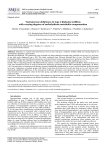
Статья научная
Objective: to evaluate total testosterone level in men with type 2 diabetes mellitus (DM) and varying degrees of carbohydrate metabolic compensation. Materials and Methods. The continuous cross-sectional non-interventional screening study included 100 men 45 [43; 48] years of age with newly diagnosed type 2 DM. The study continued from February through May of 2021. The level of glycated hemoglobin (HbA1c) and total blood testosterone were determined. Group comparisons were performed via Mann–Whitney U test, Kruskal–Wallis test and Fisher’s exact test. The differences were assumed statistically significant at p<0.05. Results. When comparing patients with different HbA1c content, we discovered that in patients with HbA1c from less than 6.5 to 9.9%, total testosterone levels as well as testosterone deficiency prevalence did not differ statistically significantly. At HbA1c -12%, the prevalence of testosterone deficiency increased statistically significantly (p<0.001), and testosterone levels decreased (p<0.001). Comparison of patient groups with HbA1c levels from less than 6.5 to 9.9% and from 10 to 11.9% did not yield statistically significant differences in the testosterone deficiency prevalence and testosterone content. However, there was a trend towards worse parameter values in the latter group, especially because patients with HbA1c levels from less than 6.5 to 9.9% were older. Conclusion. Total testosterone levels in type 2 DM patients are associated with carbohydrate metabolic compensation. Negative impact on testosterone production was detected in patients with HbA1c content of ≥10%.
Бесплатно

